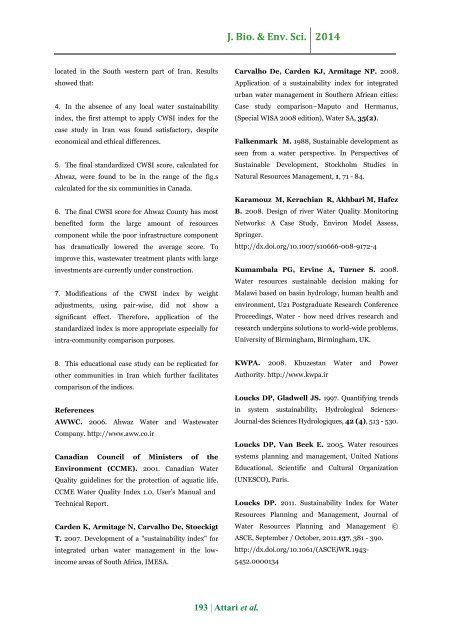Assessing of canadian water sustainability ındex (CWSI) in ahwaz county located in south west of Iran
Abstract Sustainability of water resources is vital especially for developing countries such as Iran which are located in the Middle East and North Africa (MENA) region where water is scarce. To balance the high demand of water for economic growth and at the same time preserve the environment for present and future generations, sustainability of water resources should be considered by monitoring and data mining. For this purpose, several quantified indices have been proposed and applied worldwide recently. In this paper, the Canadian Water Sustainability Index (CWSI) proposed by PRI, has been trailed for the case of Ahwaz County, a community located in South West of Iran fed by Karun River. Required data for the composite CWSI score which is the average of five major theme-based components (i.e. resource, ecosystem health, infrastructure, human health capacity) was collected according to the PRI evaluation method. In addition to the standardized CWSI, the final index was also calculated considering weight estimation for the five components by pair-wise comparison, using Expert Choice version 2000. Results showed that application of this index as a policy tool, with some modifications in weights, was satisfactory for the educational case study and could be replicated for other communities in Iran.
Abstract
Sustainability of water resources is vital especially for developing countries such as Iran which are located in the Middle East and North Africa (MENA) region where water is scarce. To balance the high demand of water for economic growth and at the same time preserve the environment for present and future generations, sustainability of water resources should be considered by monitoring and data mining. For this purpose, several quantified indices have been proposed and applied worldwide recently. In this paper, the Canadian Water Sustainability Index (CWSI) proposed by PRI, has been trailed for the case of Ahwaz County, a community located in South West of Iran fed by Karun River. Required data for the composite CWSI score which is the average of five major theme-based components (i.e. resource, ecosystem health, infrastructure, human health capacity) was collected according to the PRI evaluation method. In addition to the standardized CWSI, the final index was also calculated considering weight estimation for the five components by pair-wise comparison, using Expert Choice version 2000. Results showed that application of this index as a policy tool, with some modifications in weights, was satisfactory for the educational case study and could be replicated for other communities in Iran.
You also want an ePaper? Increase the reach of your titles
YUMPU automatically turns print PDFs into web optimized ePapers that Google loves.
J. Bio. & Env. Sci. 2014<br />
<strong>located</strong> <strong>in</strong> the South <strong>west</strong>ern part <strong>of</strong> <strong>Iran</strong>. Results<br />
showed that:<br />
4. In the absence <strong>of</strong> any local <strong>water</strong> <strong>susta<strong>in</strong>ability</strong><br />
<strong>in</strong>dex, the first attempt to apply <strong>CWSI</strong> <strong>in</strong>dex for the<br />
case study <strong>in</strong> <strong>Iran</strong> was found satisfactory, despite<br />
economical and ethical differences.<br />
5. The f<strong>in</strong>al standardized <strong>CWSI</strong> score, calculated for<br />
Ahwaz, were found to be <strong>in</strong> the range <strong>of</strong> the fig.s<br />
calculated for the six communities <strong>in</strong> Canada.<br />
6. The f<strong>in</strong>al <strong>CWSI</strong> score for Ahwaz County has most<br />
benefited form the large amount <strong>of</strong> resources<br />
component while the poor <strong>in</strong>frastructure component<br />
has dramatically lowered the average score. To<br />
improve this, waste<strong>water</strong> treatment plants with large<br />
<strong>in</strong>vestments are currently under construction.<br />
7. Modifications <strong>of</strong> the <strong>CWSI</strong> <strong>in</strong>dex by weight<br />
adjustments, us<strong>in</strong>g pair-wise, did not show a<br />
significant effect. Therefore, application <strong>of</strong> the<br />
standardized <strong>in</strong>dex is more appropriate especially for<br />
<strong>in</strong>tra-community comparison purposes.<br />
Carvalho De, Carden KJ, Armitage NP. 2008.<br />
Application <strong>of</strong> a <strong>susta<strong>in</strong>ability</strong> <strong>in</strong>dex for <strong>in</strong>tegrated<br />
urban <strong>water</strong> management <strong>in</strong> Southern African cities:<br />
Case study comparison–Maputo and Hermanus,<br />
(Special WISA 2008 edition), Water SA, 35(2).<br />
Falkenmark M. 1988, Susta<strong>in</strong>able development as<br />
seen from a <strong>water</strong> perspective. In Perspectives <strong>of</strong><br />
Susta<strong>in</strong>able Development, Stockholm Studies <strong>in</strong><br />
Natural Resources Management, 1, 71 - 84.<br />
Karamouz M, Kerachian R, Akhbari M, Hafez<br />
B. 2008. Design <strong>of</strong> river Water Quality Monitor<strong>in</strong>g<br />
Networks: A Case Study, Environ Model Assess,<br />
Spr<strong>in</strong>ger.<br />
http://dx.doi.org/10.1007/s10666-008-9172-4<br />
Kumambala PG, Erv<strong>in</strong>e A, Turner S. 2008.<br />
Water resources susta<strong>in</strong>able decision mak<strong>in</strong>g for<br />
Malawi based on bas<strong>in</strong> hydrology, human health and<br />
environment, U21 Postgraduate Research Conference<br />
Proceed<strong>in</strong>gs, Water - how need drives research and<br />
research underp<strong>in</strong>s solutions to world-wide problems,<br />
University <strong>of</strong> Birm<strong>in</strong>gham, Birm<strong>in</strong>gham, UK.<br />
8. This educational case study can be replicated for<br />
other communities <strong>in</strong> <strong>Iran</strong> which further facilitates<br />
comparison <strong>of</strong> the <strong>in</strong>dices.<br />
References<br />
AWWC. 2006. Ahwaz Water and Waste<strong>water</strong><br />
Company. http://www.aww.co.ir<br />
Canadian Council <strong>of</strong> M<strong>in</strong>isters <strong>of</strong> the<br />
Environment (CCME). 2001. Canadian Water<br />
Quality guidel<strong>in</strong>es for the protection <strong>of</strong> aquatic life.<br />
CCME Water Quality Index 1.0, User’s Manual and<br />
Technical Report.<br />
Carden K, Armitage N, Carvalho De, Stoeckigt<br />
T. 2007. Development <strong>of</strong> a "<strong>susta<strong>in</strong>ability</strong> <strong>in</strong>dex" for<br />
<strong>in</strong>tegrated urban <strong>water</strong> management <strong>in</strong> the low<strong>in</strong>come<br />
areas <strong>of</strong> South Africa, IMESA.<br />
KWPA. 2008. Khuzestan Water and Power<br />
Authority. http://www.kwpa.ir<br />
Loucks DP, Gladwell JS. 1997. Quantify<strong>in</strong>g trends<br />
<strong>in</strong> system <strong>susta<strong>in</strong>ability</strong>, Hydrological Sciences-<br />
Journal-des Sciences Hydrologiques, 42 (4), 513 - 530.<br />
Loucks DP, Van Beek E. 2005. Water resources<br />
systems plann<strong>in</strong>g and management, United Nations<br />
Educational, Scientific and Cultural Organization<br />
(UNESCO), Paris.<br />
Loucks DP. 2011. Susta<strong>in</strong>ability Index for Water<br />
Resources Plann<strong>in</strong>g and Management, Journal <strong>of</strong><br />
Water Resources Plann<strong>in</strong>g and Management ©<br />
ASCE, September / October, 2011.137, 381 - 390.<br />
http://dx.doi.org/10.1061/(ASCE)WR.1943-<br />
5452.0000134<br />
193 | Attari et al.





![Review on: impact of seed rates and method of sowing on yield and yield related traits of Teff [Eragrostis teff (Zucc.) Trotter] | IJAAR @yumpu](https://documents.yumpu.com/000/066/025/853/c0a2f1eefa2ed71422e741fbc2b37a5fd6200cb1/6b7767675149533469736965546e4c6a4e57325054773d3d/4f6e6531383245617a537a49397878747846574858513d3d.jpg?AWSAccessKeyId=AKIAICNEWSPSEKTJ5M3Q&Expires=1715425200&Signature=L2iI9NBUDgzXCl8vO2XIa8aol5Y%3D)












